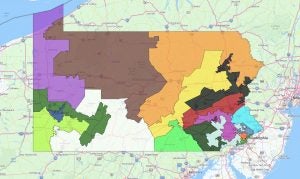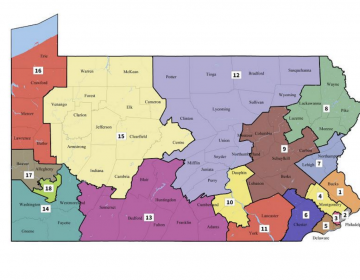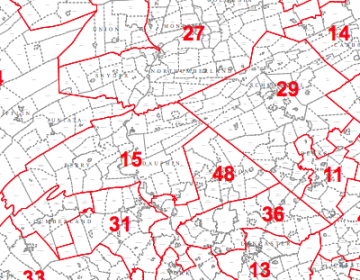Touring Pa.’s 7th congressional district, one of the nation’s most gerrymandered
Pennsylvania's 7th Congressional district, which has an eye-popping shape that spans five counties, has been described in terms of a Disney cartoon: Goofy kicking Donald Duck.
Listen 4:35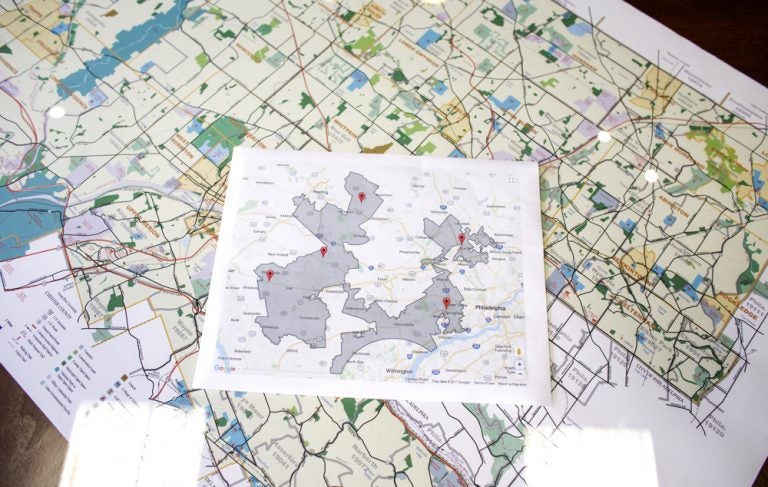
A map of the 7th congressional district as drawn in 2011. The district incorporates most of Delaware County and portions of Chester, Montgomery, Berks and Lancaster Counties. (Dan Gleiter/pennlive.com)
What’s it feel like to live along the border of one of the most gerrymandered congressional districts in the U.S.?
Just ask Bonnie Marcus and Bill Van Wie, who live at Kendall Crosslands, a picturesque retirement community in Chester County.
“Have you seen what we look like? We’re a joke,” said Marcus, a Democratic poll worker who gathered a group of neighbors at the community center to talk gerrymandering.
“I don’t think there’s a way they can make it worse,” Van Wie chimed in.
“Of course they can,” Marcus said, setting off a volley of laughter around the patio table.
“Well,” Van Wie said, sheepishly, “that’s not an invitation.”

The community sits on the outskirts of Pennsylvania’s 7th congressional district, which has an eye-popping shape that spans five counties. It’s been described in terms of a Disney cartoon: like Goofy kicking Donald Duck.
When the state redrew Pennsylvania’s congressional map following the 2010 census, its roughly 900 residents were punted from the 7th district into the 16th in what seems to have been a direct attempt to diffuse the power of Democrats in the region.
U.S. Rep. Patrick Meehan (R-7th) still sends mailers to residents of Kendal-Crosslands despite the fact that the Quaker-run retirement community was carved out of Meehan’s district — literally, in the shape of a dagger —and is represented by Lloyd Smucker (R-16th), who lives an hour away in Lancaster County.
That makes retirees like Georgette Siegel, a Democrat, feel like she’s been politically abandoned — a designed afterthought to the Republicans who represent her in Harrisburg and D.C.
“I’m not asking that they always agree with my opinions but that they’d take them into account,” she said.
Before the 2011 redistricting, the 7th district had been considered politically competitive. From the mid 1970s to the late 1980s it was held by a Democrat. From then until the mid 2000s it was held by a Republican. Democrat Joe Sestak won the seat in 2006 and 2008. Meehan won a relatively tight race there in 2010, before the lines were redrawn. Since, he’s defeated challengers with relative ease.
Retirees at Kendal-Crosslands complain that their overtures to politicians go ignored. If they get any kind of interaction, it usually comes via canned form letters, sometimes responding to issues they didn’t raise. One politician’s office thanked a resident for their interest in deer hunting-in response to a letter about health care.
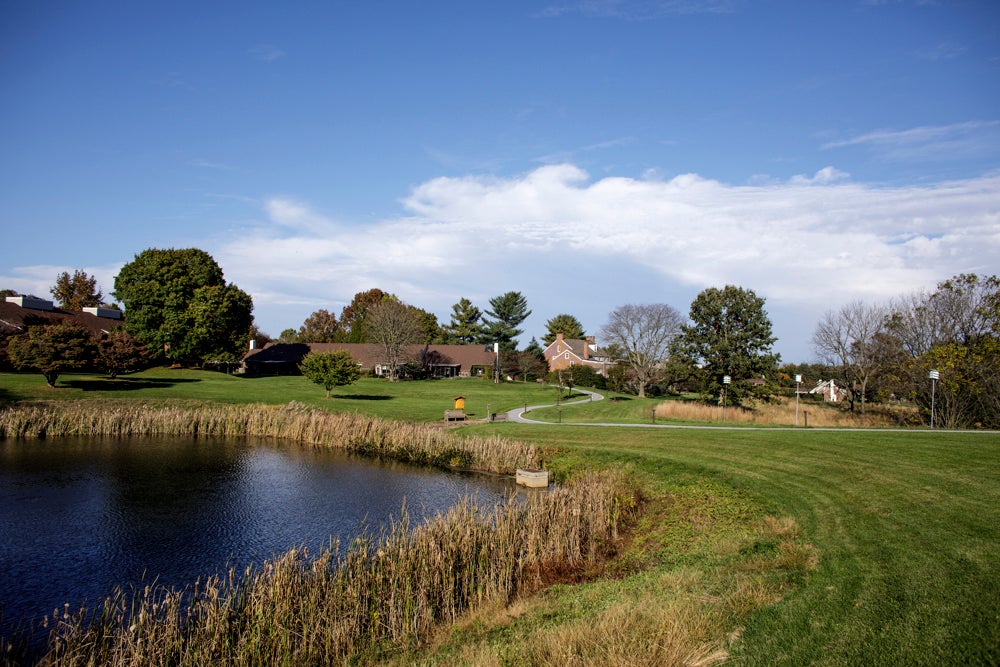
State GOP leaders who drew the map defend its lines and point to the fact that it was upheld in court at the time. It is now subject of two lawsuits — one in state courts, another in federal.
A little farther up the road, the Democrat-leaning Kennett Square was similarly carved out of the 7th district. The borough’s shape makes it look like a square notch was cut into one of Goofy’s knees.
That’s particularly galling to Wayne Braffman, a local Democratic council member who’s become an advocate on the issue.
“This is not a political issue or a partisan issue. I knocked on doors in the borough — and I just knock on every door, I don’t care who they are — and all I had to do was show them the map of the 7th, and they said, ‘Where do I sign,’” he said.

A 45-minute drive north of Kennett Square, in King of Prussia, two chunks of the 7th district are connected by a narrow isthmus of land barely wider than the property line of Creed’s Seafood and Steaks.
Since 1982, the restaurant has been a favorite watering hole for business and political leaders, even a governor or two, and maybe a few of those responsible for those labyrinthine district lines.
“What happens at Creed’s, never happened,” jokes owner Jim Creed.
He’s happy, though, to play host.
“We don’t care if they’re Republican, Democrat, Independent or Martians, as long as they’re paying,” he said.

Standing outside of the restaurant, you’re surrounded by the zig-zagging lines of three different congressional districts. Montgomery County is represented by five different congressmen, none of whom live there.
“There’s no one who gets up every morning and says, ‘What can I do for Montgomery County today?'” said Val Arkoosh, a Democrat who chairs the Montgomery County Board of Commissioners.
She fears that the state’s map has been drawn in such a way that disadvantages the County.
For instance, she cites the fact that President Donald Trump’s proposed budget would gut the public transportation funding that’s been counted on to build a new commuter rail line connecting Philly and King of Prussia.
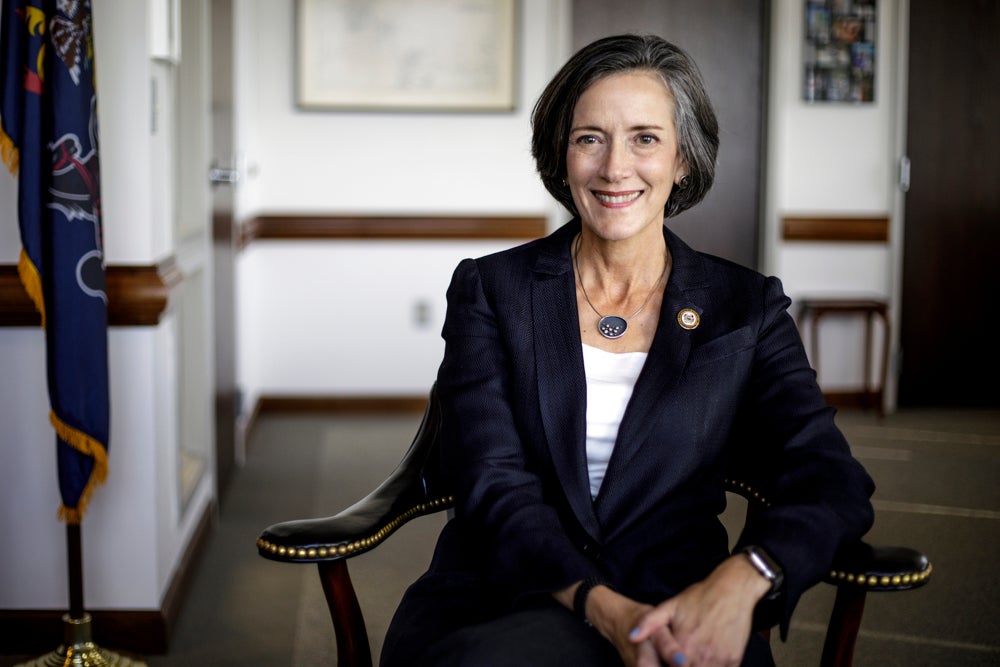
“In the inevitable horse-trading that happens to build a budget, is there going to be somebody that’s really focused on how important that particular thing is to Montgomery County? I don’t know the answer to that yet,” she said.
There’s an absurd humor to these political machinations, but Arkoosh says there are also real consequences.
“I can’t tell you how many times I hear, ‘Why should I vote, it doesn’t matter?’” she said. “If that doesn’t put the fear of the future of our Democracy into everybody’s heart, people need to wake up.”
—
This story is part of our redistricting series “Over the Line”, a collaboration with PennLive, WITF and other public media stations across the state.
Read Wallace McKelvey’s full tour of the 7th district here.
WHYY is your source for fact-based, in-depth journalism and information. As a nonprofit organization, we rely on financial support from readers like you. Please give today.



